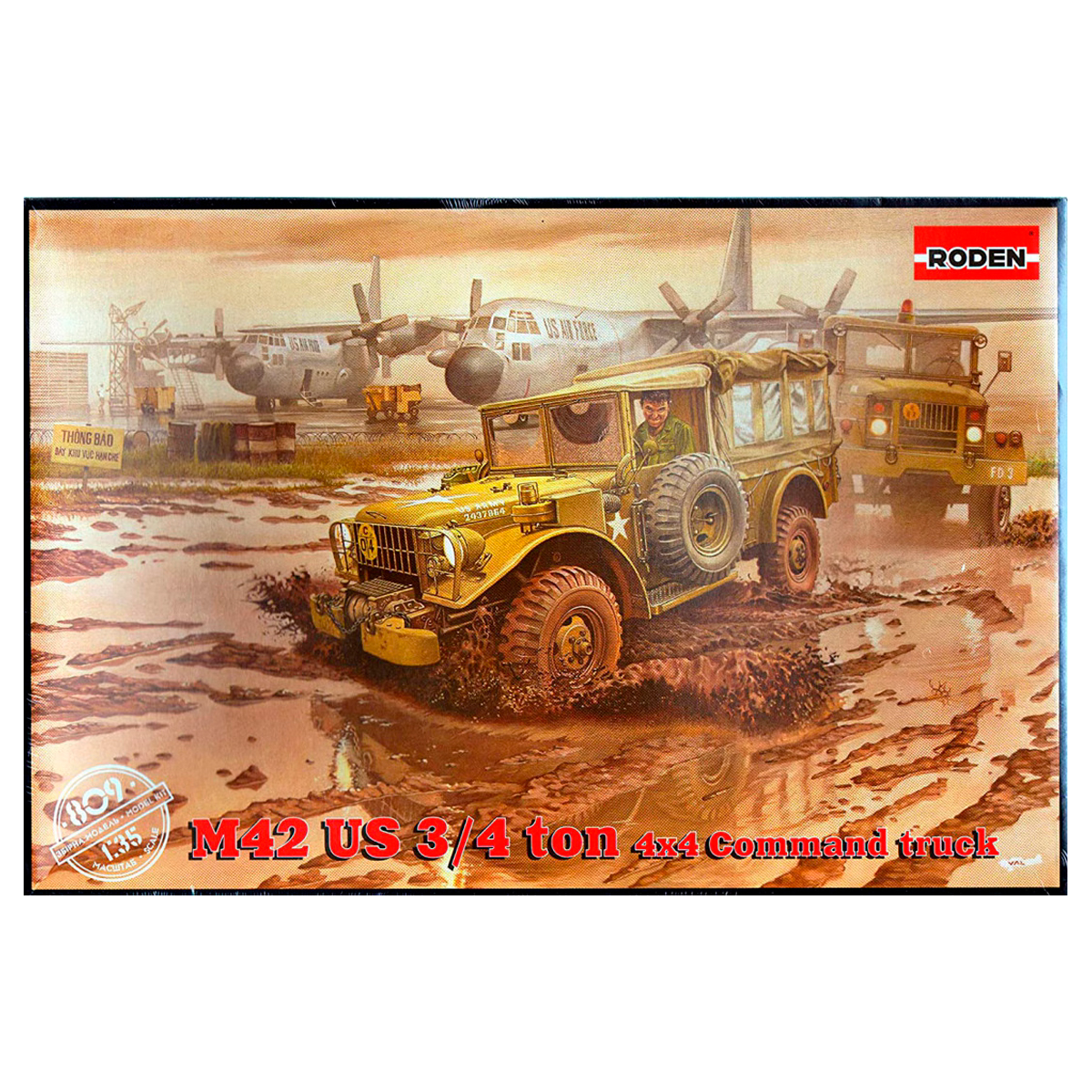1/35 M42 US 3/4 ton 4×4 Command truck
49,49€
In stock

*Please check our Privacy Policies to see how to we use your personal data.
*Por favor revisa nuestra Política de Privacidad para ver como tratamos tus datos personales
Roden 1/35 M42 US 3/4 ton 4×4 Command truck
Among the huge number of different trucks used by the American army throughout the modern era (since World War II), only some can rightfully be called legendary, as it is difficult to distinguish the part they played in terms of the widespread use of the vehicles in everyday military life. One such truck was the M37 developed by the Dodge company in 1950, which incorporated all the best features of its WWII predecessors.
The M37, along with the previous models in the WC series, had a 6-cylinder engine of 230 cubic inches (3.8 liters), and a four-speed non synchronized gearbox. However, its chassis was lengthened, and the driver’s cabin was separated from the body. The truck also received a new two-speed transmission. The design was successful and in 1951 around 11,000 units of this type were built, and in the next three years more than 50,000 units. The emergence of the new machine was timely – in the middle of 1950 the Korean War began, in which the U.S. was directly involved before three years were out. In actual military operating conditions, the M37 quickly found itself indispensable, and many special vehicles were developed from it (a command truck, a communications vehicle, an airfield fire engine, an ambulance, etc.), and so it became a real find for the army.
The M42 Command Car, adapted from the basic M37 truck, was not a separate production series. To adapt an ordinary M37 into the M42, the Dodge firm produced a special kit to enable the rapid conversion of a standard truck into a Command Car. This kit consisted of an awning of a new type with side windows, a split rear end curtain, stronger internal lighting which permitted consideration of military maps directly in the vehicle during field meetings, and a folding table in the middle of the car body. Also, M42s were fitted out with more powerful radio equipment for more reliable communications in field conditions. When processing the standard truck into the Command Car, it was obligatory to change an individual dataplate inside the driver’s cabin, which was then noted for the converted vehicles in a military report. M42 numbers in comparison with the standard M37 were rather small, however in conjunction with the ‘ordinary’ trucks of this type they also participated in many of the military conflicts of the second half of the 20th Century.
Roden 1/35 M42 US 3/4 ton 4×4 Command truck
Entre el enorme número de camiones diferentes utilizados por el ejército estadounidense a lo largo de la era moderna (desde la Segunda Guerra Mundial), sólo algunos pueden calificarse con razón de legendarios, ya que es difícil distinguir el papel que desempeñaron en cuanto al uso generalizado de los vehículos en la vida militar cotidiana. Uno de estos camiones fue el M37 desarrollado por la empresa Dodge en 1950, que incorporaba todas las mejores características de sus predecesores de la Segunda Guerra Mundial.
El M37, junto con los modelos anteriores de la serie WC, tenía un motor de 6 cilindros de 230 pulgadas cúbicas (3,8 litros) y una caja de cambios no sincronizada de cuatro velocidades. Sin embargo, su chasis se alargó y la cabina del conductor se separó de la carrocería. El camión también recibió una nueva transmisión de dos velocidades. El diseño tuvo éxito y en 1951 se construyeron unas 11.000 unidades de este tipo, y en los tres años siguientes más de 50.000 unidades. La aparición de la nueva máquina fue oportuna: a mediados de 1950 comenzó la Guerra de Corea, en la que Estados Unidos se vio directamente implicado antes de que transcurrieran tres años. En condiciones reales de operación militar, el M37 se reveló rápidamente indispensable, y a partir de él se desarrollaron numerosos vehículos especiales (un camión de mando, un vehículo de comunicaciones, un camión de bomberos para aeródromos, una ambulancia, etc.), por lo que se convirtió en un verdadero hallazgo para el ejército.
El Command Car M42, adaptado a partir del camión básico M37, no fue una serie de producción independiente. Para adaptar un M37 ordinario al M42, la empresa Dodge fabricó un kit especial que permitía convertir rápidamente un camión estándar en un Command Car. Este kit consistía en un toldo de nuevo tipo con ventanas laterales, una cortina trasera dividida, una iluminación interior más potente que permitía examinar los mapas militares directamente en el vehículo durante las reuniones sobre el terreno, y una mesa plegable en el centro de la carrocería. Además, los M42 fueron dotados de equipos de radio más potentes para unas comunicaciones más fiables en condiciones de campo. Al transformar el camión estándar en coche de mando, era obligatorio cambiar una placa de datos individual dentro de la cabina del conductor, que luego se anotaba para los vehículos transformados en un informe militar. El número de M42 en comparación con los M37 estándar era más bien reducido, sin embargo, junto con los camiones «ordinarios» de este tipo también participaron en muchos de los conflictos militares de la segunda mitad del siglo XX.






 Request of SDS product data file / Product security
Request of SDS product data file / Product security